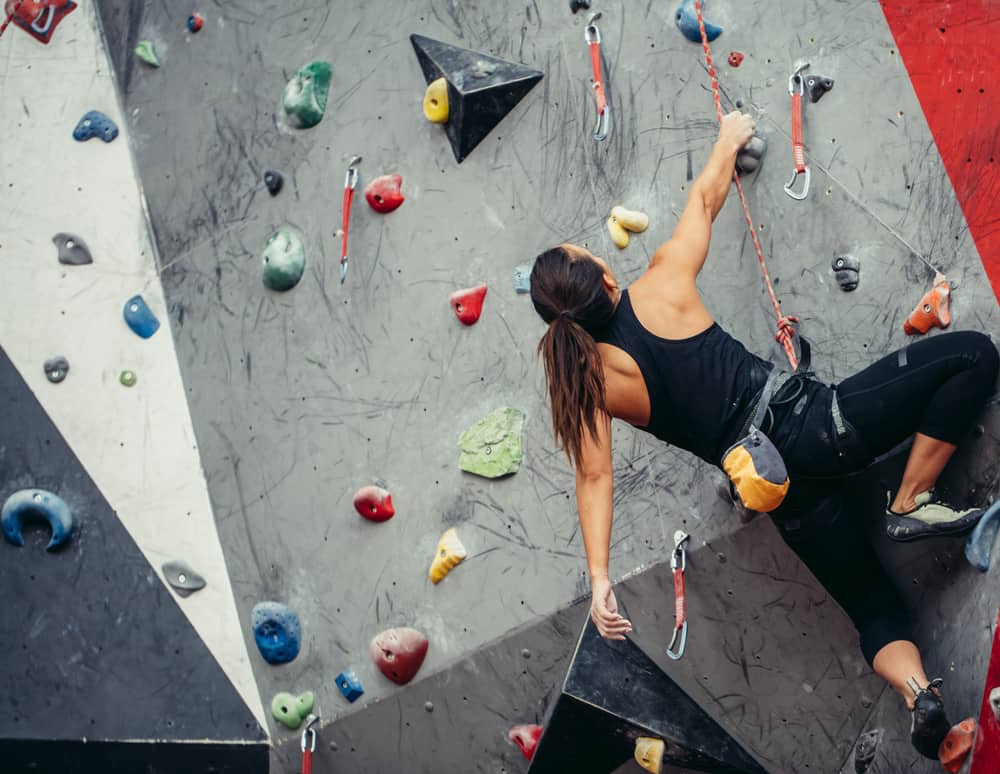There is a debate on whether indoor bouldering is dangerous. Some climbers argue that the lack of outdoor scenery and features can make indoor bouldering more difficult, as climbers may be less likely to spot hazards.
Some worry that indoor climbing can cause overuse injuries because climbers may overestimate their abilities. Indoor climbing is safer than outside. Indoor climbers have more control, making it easier to avoid risks.

Additionally, many climbing gyms have staff who can assist if necessary. While indoor bouldering carries some risk, it is generally considered safe in a controlled environment.
Indoor bouldering is generally safe when done in a controlled environment. Climbers should be aware of and avoid potential dangers. If you’re new to bouldering, start in a climbing gym to learn the ropes (literally and figuratively).
Table of Contents
How to Stay Safe While Indoor Bouldering
Bouldering can be a fun and challenging sport, but taking some safety precautions is essential to minimize the risk of injury. One of the most important things to remember is to stay hydrated. Ensure you drink plenty of water before and after your bouldering session to prevent dehydration.

Another essential safety precaution is to wear the proper gear. Make sure your shoes fit correctly and have a good grip. Wear clothing that won’t get caught in handholds or footholds, and avoid baggy clothes that could get in the way.
Finally, be aware of your surroundings and pay attention to other climbers. Try not to crowd other climbers, and always be mindful of your limitations. Don’t attempt climbs that are too difficult for you; always use a spotter when necessary.
Top 5 Safety Tips for Indoor Bouldering
Be safe during indoor bouldering because the sport can be dangerous if you’re not careful.
Here are the top five safety tips to remember:
- Make sure you know how to boulder correctly before climbing. Improper techniques can lead to accidents.
- Always wear a helmet when bouldering. This will help protect your head if you fall.
- Wear proper safety gear when climbing, including a harness, shoes with good grip, and a chalk bag.
- Don’t try to climb beyond your ability. If you’re not comfortable with a particular move, don’t try it.
- Be aware of your surroundings and avoid climbing near other climbers or obstacles.
What to Do if You Get Injured While Indoor Bouldering
You can’t say enough about the importance of knowing what to do if you get hurt during indoor bouldering. Accidents can happen even in the safest places, so it’s essential to be ready.

Here are a few tips on what to do if you do get injured:
- If you are experiencing pain, stop climbing and seek medical attention. Continuing to rise despite pain can result in further injury.
- If you are bleeding, clean the wound and apply pressure to stem the bleeding.
- If you have a sprain or fracture, immobilize the area and seek medical attention.
- If you are experiencing nausea or dizziness, sit down and drink plenty of fluids.
- Stay calm and focused; knowing what to do in the event of an injury can help minimize its severity.
The Dangers of Indoor Bouldering and How to Avoid Them
Even though indoor bouldering involves a degree of danger, the activity is generally considered safe if carried out in a well-managed area. Climbers, however, should be aware of the potential risks and take care to protect themselves from them.

In addition, if you are new to bouldering, it is recommended that you begin your training in a climbing gym to get acclimated to the sport and learn the ropes (both literally and figuratively) in a secure environment.
The following list enumerates some of the dangers of indoor bouldering and offers suggestions on how to avoid them:
- improper techniques can lead to accidents
- not wearing a helmet when bouldering can result in head injuries
- failing to wear proper safety gear (e.g., harness, shoes, chalk bag) can increase the risk of injury
- attempting climbs that are beyond one’s ability level can cause serious injuries
- not paying attention to one’s surroundings can lead to accidents (e.g., falling off the wall or into other climbers)
How to Stay Safe While Enjoying the Sport of Indoor Bouldering
It is impossible to emphasize the significance of observing these preventative measures. Bouldering is an activity that may be a lot of fun, but if you aren’t careful, it can also be dangerous.

Indoor bouldering is a great workout and can be a lot of fun, but as with any sport, there are risks involved. The good news is that you can do plenty of things to minimize the dangers and have a great time while bouldering indoors.
Here are some tips on Indoor bouldering safety:
- Use a crash pad: A crash pad is a thick piece of foam that cushions your fall if you happen to slip while climbing. It’s a good idea to use one whenever you’re bouldering, especially if you’re new to the sport.
- Never try anything beyond your ability: This may seem common sense, but it’s important to remember that indoor bouldering can be dangerous if you try to do something beyond your skill level. Don’t try a move you’re not comfortable with.
- Don’t boulder alone: It’s always best to have someone else around in an emergency.
- Be aware of your surroundings: Pay attention to where you are and what’s around you to avoid obstacles and other climbers.
- Wear proper safety gear: Make sure you have the right shoes and clothing for bouldering, and always wear a helmet to protect your head.
- Use chalk: Chalk helps you keep a firm grip on the wall, which can help prevent falls.
- Warm up before climbing: A good warm-up will help avoid injuries.
- Cool down after you climb: Just as it’s essential to warm up before you climb, it’s also important to cool down afterward. This will help your muscles recover from the workout.
- Listen to your body: Take a break if you’re tired or sore. Pushing yourself too hard can lead to accidents.
- Have fun: Bouldering is supposed to be enjoyable, so take breaks and enjoy the experience.


